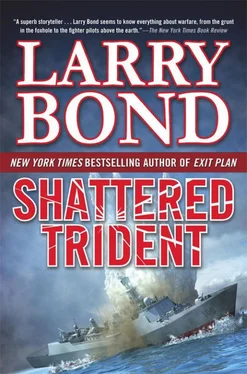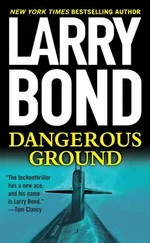Immediately after taking command, Jerry and his new XO had spent a lot of time together, getting to know each other and working out Jerry’s policies as North Dakota ’s new skipper. These conferences usually involved refreshing beverages and case studies often referred to as “sea stories,” but that did not diminish their value.
Prior to assuming command, Jerry attended “PCO school,” a grueling three-month course that starts in the classroom, but quickly moves to a real sub operating against other surface ships, subs, and aircraft. During the “free play” exercises, Jerry practiced torpedo approaches, trailing operations, laid a dummy minefield, and simulated launching Tomahawk cruise missiles. He’d even operated against another nuclear submarine, which sounded hard and proved to be much more difficult than that.
Three months of training and thinking about command had increased his skills and expanded his consciousness. But he’d worked for three very different commanding officers for years at a time, seeing what worked for each of them. Now he had to make up his own style. He just didn’t want to make it up at the last minute.
* * *
Jerry was lost in paperwork when the phone buzzed. It was Thigpen’s voice.
“Skipper, would you please join us in control? We have the results from the UUV’s latest data dump.”
“Interesting?” Jerry asked.
“You will want to see this,” the XO answered cryptically.
Lieutenant Russ Iverson, the main propulsion assistant, had the OOD watch, and gave Jerry the standard status report when he entered control, but there were no surprises. They were at depth and patrol speed, headed for the next waypoint. There were half a dozen sonar contacts, but all were civilian.
The action was in the aft starboard corner of the control room. Lieutenant Dave Covey, the weapons officer, had taken over a spare console and used it to display a plot of the UUV’s activity. The XO watched over his shoulder, and made room for Jerry when he appeared.
A map was overlaid with the irregular shape of the vehicle’s patrol zone. Different tracks drew colored lines through the zone, marking the progress of ships detected and tracked by Minot’s sonars. One of the tracks was different, though, a tangle of lines that looked like a coil of rope.
The track of the UUV showed on the display as a different-colored line, with small deviations, for the first two-thirds of its patrol, but then it became irregular, zigging one way and sharply angling back the other in what looked like a random pattern. Only Jerry’s experience with the UUV in the simulators told him this was not a malfunction.
“It’s reacting to this contact,” Covey reported. He highlighted the tangled track and a window with details about the vessel appeared. Time of first detection, bearings, signal strength, identity…
“It’s a submarine,” Covey explained. Jerry wasn’t sure whether it was pride or excitement in the lieutenant’s voice. “Just like it was supposed to, as soon as Minot figured out it wasn’t a surface vessel, it started maneuvering to localize the contact, but not getting too close. What’s interesting is that the contact isn’t transiting.”
Jerry studied the track’s data carefully. It had a low blade rate, as well as low signal strength. Covey volunteered, “The acoustic data’s already been sent over to our sonarmen. They’re running it through the system right now.”
Jerry looked up at the port VLSD. The sub was loitering to the west of Hainan Island. Minot had gotten close enough to get elevation data on the signal, which allowed them to calculate the contact’s depth. The water wasn’t terribly deep there, and it looked like the boat was almost hugging the bottom, creeping at bare steerageway, conserving its battery power, drawing large ovals in the water.
Lieutenant Gaffney came over from the sonar consoles. “My guys say it’s a late Kilo, a Project 636. Blade rate’s consistent with three knots.”
Jerry had an uneasy feeling. Why would a Chinese diesel boat be hanging out to the west of Hainan Island? It was out of the exercise area the Chinese had declared, and away from the shipping lanes. “XO, did we update the intel plot during the last comms window?”
“Of course,” Thigpen replied. “Squadron Fifteen’s update is about three hours old.”
“How many of the Chinese Kilos are we tracking?”
Thigpen sat down at the next console and called up the intelligence summary. “They have twelve Kilos, all Russian-built, purchased in ’94 and ’97. Two are older Project 877s, the remaining ten are the later models, Project 636.” He paused for a minute, scrolling.
“And as of three hours ago, two were reported as being in the yards, and the rest in harbor. Three are assigned to the sub base at Yalong Bay, and they’re still there, if the intel is right.”
“Assume it was right three hours ago,” Jerry said. “There’s no way one could have taken station that far to the west without us seeing it.”
“Not without it having a warp drive,” Thigpen added. “At a top speed of nineteen knots for one hour, it would have a flat battery a third of the way to that location.”
“Then we have to assume it isn’t a Chinese boat. Stu, go back and tell your techs to take that signal apart. XO, punch the intelligence database and see who else might be operating a Kilo, besides the obvious answer.”
Jerry studied the screen with Covey, trying to pull more information out of the display. Was the sub skipper following a pattern?
Five minutes later, Thigpen reported back to Jerry. “Aside from China, India’s got ten and Vietnam currently has three. The Indian boats are early marks, Project 877. Vietnam’s are Project 636s. The latest unit was just delivered this year.”
Jerry nodded solemnly. “That’s what I remembered, but I was hoping there was another possibility.” He turned around, toward the sonarmen, with Gaffney standing behind them. Gaffney noticed the movement and hurried over.
“Nothing yet, sir,” the sonar officer reported. “It’s definitely a 636 Kilo. It doesn’t match any of the recorded signatures, but then we don’t have all the Chinese boats in the library.”
“Do we have any signatures at all on the Vietnamese subs?” Jerry asked.
“No, sir. The library would have automatically…” He paused, processing the question. “You think this is a Vietnamese boat? Payback for Vinaship Sea ? But why are they way over here?”
“Damfino, Stu. We need more data.”
Gaffney shrugged. “Well… one of my techs noticed that the tonals were very ‘clean.’ There was very little noise around each of the lines.”
Jerry understood the sonar officer’s reference. New machinery ran smoothly, but as gears and bearings wore down, the sound each piece of equipment made became fuzzier, less a single tight frequency and more a band of sounds centered around the tone. Some civilian engineers used frequency analyzers to diagnose problems with turbines and generators. North Dakota ’s sonars were sensitive enough to hear it as well, even when it wasn’t bad enough to need fixing.
“So it’s a new Project 636,” Jerry said. “Go compare the newest Chinese 636 in our library with this signal.”
Gaffney answered, “Aye, sir,” and headed back to the sonar station. It only took a moment to set up the comparison, but then several minutes for the techs to examine the displays. Gaffney came back, reporting, “The latest Chinese boat we have in the library was delivered in ’07. My techs, especially Andersen, can see the difference. If a cleaner signal means a new boat, then this one is newer than 2007. Maybe a lot newer.”
Jerry studied the UUV’s data, looking for another answer besides the ominous one, the possibility he couldn’t ignore. “It would be nice to come up with some other reason for a Vietnamese diesel attack boat to take station off Hainan Island. Can any of you think of something else?”
Читать дальше

![Никки Сикс - Героиновые дневники. Год из жизни павшей рок-звезды[The Heroin Diaries - A Year in the Life of a Shattered Rock Star]](/books/78612/nikki-siks-geroinovye-dnevniki-god-iz-zhizni-pavshej-rok-zvezdy-the-heroin-diaries-a-yea-thumb.webp)










